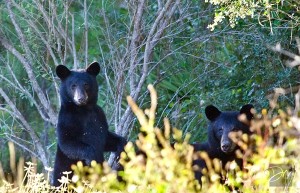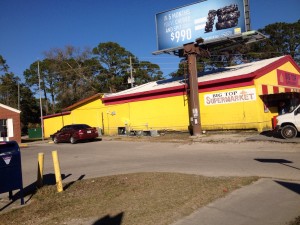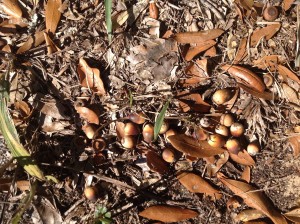
Carrabelle bypass, a place where bears historically come to the coast to forage for acorns in the fall.
Last week I went searching for evidence of Florida black bears down along our coast. They are shy creatures, generally night-dwelling. I always watch for them, though, and as the poet Mary Oliver says “…everywhere I look on the scratchy hillsides, shadows seem to grow shoulders.”
I walked in places I know they forage and walk. I found acorns they hadn’t yet eaten on the side of the road.
I saw scat they had left in the middle of the High Bluff Coastal Trail. After all our winter rains, the bear poop was sinking into sand, leaving behind undigested acorns and plant matter the animals had eaten last month.
I even visited the dumpster behind the Big Top supermarket in Eastpoint where the trouble began.
It used to be rare to see wild black bears in North Florida. You could ride along Highway 319 from the Ochlockonee River bridge to the FSU Marine Lab and maybe one year, maybe 20 years after you started hoping and watching, you’d spot something larger than a dog, with longer legs than you could believe. It would lope across the highway in front of your car and you would turn to your companions and try to find words to describe the thrilling bear-ness of the animal, like no bear you’d ever seen sleeping at the Tallahassee Junior Museum. Most of all you’d notice its long athletic legs, so clearly built for pacing the many square miles of its huge home range.
I walked in those coastal places last week in memory of the four bears that have been killed in Eastpoint since Christmas, and the two cubs relocated to Osceola National Forest after their mother was euthanized. I mourned bears yet to be killed. I sorrowed for my former colleagues at FWC who went to school to learn how to manage and protect wildlife, but instead must trap and euthanize bear after bear after bear. And I grieved for the young girl who had unknowingly walked between one of those now dead bears and the uncovered dumpster that it had come to rely on for easy calories. She suffered facial injuries in the encounter but is recovered now.
Neither the bears, nor the girl, nor the wildlife biologists are at fault in this sad story. I’ll tell you who is. Blame lies squarely with the owners of the dumpsters and garbage cans and dog bowls who refused to secure their aromatic trash, food, and game carcasses. A lot of resources have been spent to educate people in Florida bear country about how to minimize bear-people conflicts, but some people refuse to comply. And bears will always lose in those cases: a bear habituated to human food and garbage will eventually be a dead bear.
More Food For Thought: A succinct publication called In a Bear’s Quest for Calories explains why WE–not the bears–are the problem. The wild bear must eat 20,000 calories a day to prepare for denning through the cold months. Forest foods like acorns and saw palmetto aren’t nearly as calorically dense as, say, dog chow. A bear would have to eat 11,165 acorns to ingest the same number of calories as she could find in a 25 pound bag of dog chow left on someone’s back porch!
Share On:





Susan, you are simply amazing. Wonderful how your thoughts lift my spirit. You give me courage. – Madeleine
Excellent article. I shared your thoughts when I read the story in the newspaper. Unfortunately, I don’t think most people care any more if they and their children never see a wild bear or a panther or a bobcat, etc.
Some of us who live in Franklin County have ALWAYS said “it’s a people problem, not a bear problem”. But, who listens? Not our County Commissioners, and not the people who leave trash and food sources around their homes and businesses.
The ignorance of some, leads to the demise of nature.
Have you noticed there are many fewer acorns this year? We did see quite a few at St. Joseph State Park along the ridge trail in November, but as a whole – very few. None noticeable on our huge live oak at home.
Donna
Thank you, friends, for your thoughtfulness. It helps to hear from you so much. Donna, I saw an abundance of acorns down in Carrabelle. But you are our experts!
Funny, just yesterday I was thinking about the one and only bear I’ve seen in Florida loping (the right word Susan!) across the Tamiami Trail near Collier Seminole SP. And here you are with a bear story of wisdom and good sense. Thank you yet again.
Thanks for nailing the source of the problem. Great blog, Sue. I’ll pass it on.
Thank you Susan for this timely post. For a fascinating account of black bear behavior and some good insight into black bears’ interactions with humans, read “Out on a Limb” by Benjamin KIlham– bottom line for the current controversy:
“the solution to the nuisance bear problem is not so much about managing bears; it’s about managing people.”
“Bears are highly tolerant of humans. There are hundreds, perhaps thousands, of bear encounters every year where humans do everything wrong without any negative response from the bear. It’s important to remember, though, that in the vast majority of cases, black bears are dangerous only if you make them so. The situation is in your control; they tend to signal their intentions, and you can modify your own behavior to influence theirs.”
Some how we have to communicate this to the public.
Thank you for this post, Susan. Nothing is more exciting than seeing wild bears! It is quite a privilege to see bears in North Florida. Since I live half of the year in grizzly bear country in Montana, I know the importance of humans taking responsibility for their attractants (food and trash). In my wilderness Montana community, we take pride in having the largest concentration of grizzly bears in the the lower 48 states and very few bear encounters due to responsible human behavior. People can be taught to live responsibly around wildlife. Many of my neighbors see 15-20 bears each year with no problems to their homes or their health.
Yes, isn’t this interesting, Debo. What is so different in our two cultures, that here in coastal NW Florida, every bit as precious in its own right as the north fork in Montana, is so careless of its bears? Such a different point of view…..
Great article glad you took the time to write it. It’s a shame that FWS has to destroy bears instead of helping to protect them!
I know, Gary. I can imagine what that does to your spirit, since I, too, began as a wildlife biologist, and had to leave the field work, because it seemed that to do research, you so often had to kill what you loved, to study it. I wrote about that in my first book Tracking Desire.
At one time I commuted daily from Tallahassee to Apalachicola. One lucky day, as I approached Sopchoppy I noticed a really big, long legged “dog” coming from the south side of the road. I slowed and stopped because I was concerned it might be a lost dog. It stepped into the road, looked toward me, hesitated a moment then loped on across the road and vanished into the woods on the north side. IT WAS A BLACK BEAR! I felt what I imagine winning the lottery may feel like. I was blessed to have had this momentary interaction. I’ll not forget it ever.